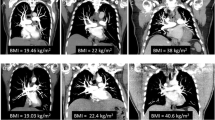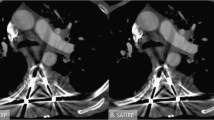Abstract
The purpose of this study was to assess in pediatric pulmonary artery (PA) reconstruction candidates the feasibility and added utility of preoperative chest computed tomography angiography (CTA) using dual-energy technique, from which perfused blood volume (PBV)/iodine maps can be generated as a surrogate of pulmonary perfusion. Pediatric PA reconstruction patients were prospectively recruited for a new dose-neutral dual-energy CTA protocol. For each case, the severity of anatomic PA obstruction was graded by two pediatric cardiovascular radiologists in consensus using a modified Qanadli index. PBV maps were qualitatively reviewed and auto-segmented using Siemens syngo.via software. Associations between Qanadli scores and PBV were assessed with Spearman correlation (r) and ROC analysis. Effective radiation doses were estimated from dose-length product and ICRP 103 k-factors, using cubic Hermite spline interpolation. 19 patients were recruited with mean (SD) age of 6.0 (5.1), 11 (57.9%) female, 11 (73.7%) anesthetized. Higher QS correlated with lower PBV, both on a whole lung (r = − 0.54, p < 0.001) and lobar (r = − 0.50, p < 0.001) basis. The lung with lowest absolute PBV was predictive of the lung with highest Qanadli score, with AUC of 0.70 (95% CI 0.47–0.93). Qualitatively, PBV maps were heterogeneous, corresponding to multifocal PA stenoses, with decreased iodine content in areas of most severe obstruction. In conclusion, dual-energy chest CTA is feasible for pediatric PA reconstruction candidates. PBV maps show deficits in regions of more severe anatomic obstruction and may serve as a novel biomarker in this population.




Similar content being viewed by others
References
Mainwaring RD, Ibrahimiye AN, Hanley FL (2016) Surgical technique for repair of peripheral pulmonary artery stenosis and other complex peripheral reconstructions. Ann Thorac Surg 102(2):e181–e183
Carrillo SA, Mainwaring RD, Patrick WL et al (2015) Surgical repair of pulmonary atresia with ventricular septal defect and major aortopulmonary collaterals with absent intrapericardial pulmonary arteries. Ann Thorac Surg 100(2):606–614
McElhinney DB, Reddy VM, Hanley FL (1998) Tetralogy of Fallot with major aortopulmonary collaterals: early total repair. Pediatr Cardiol 19(4):289–296
Ikai A (2018) Surgical strategies for pulmonary atresia with ventricular septal defect associated with major aortopulmonary collateral arteries. Gen Thorac Cardiovasc Surg 66(7):390–397
Mainwaring RD, Patrick WL, Ma M, Hanley FL (2018) An analysis of patients requiring unifocalization revision following midline unifocalization for pulmonary atresia with ventricular septal defect and major aortopulmonary collaterals. Eur J Cardiothorac Surg 54(1):63–70
Asija R, Hanley FL, Roth SJ (2013) Postoperative respiratory failure in children with tetralogy of Fallot, pulmonary atresia, and major aortopulmonary collaterals: a pilot study. Pediatr Crit Care Med 14(4):384–389
Smith NE, Fabian T, Nabagiez J (2018) Unilateral pulmonary artery atresia in an adult: a case report. Respir Med Case Rep 26:105–107
Meinel FG, Huda W, Schoepf UJ et al (2013) Diagnostic accuracy of CT angiography in infants with tetralogy of Fallot with pulmonary atresia and major aortopulmonary collateral arteries. J Cardiovasc Comput Tomogr 7(6):367–375
Lloyd DFA, Goreczny S, Austin C et al (2018) Catheter, MRI and CT imaging in newborns with pulmonary atresia with ventricular septal defect and aortopulmonary collaterals: quantifying the risks of radiation dose and anaesthetic time. Pediatr Cardiol 39(7):1308–1314
Lin MT, Wang JK, Chen YS et al (2012) Detection of pulmonary arterial morphology in tetralogy of Fallot with pulmonary atresia by computed tomography: 12 years of experience. Eur J Pediatr 171(3):579–586
Jia Q, Cen J, Li J et al (2018) Anatomy of the retro-oesophageal major aortopulmonary collateral arteries in patients with pulmonary atresia with ventricular septal defect: results from preoperative CTA. Eur Radiol 28(7):3066–3074
Yatsuyanagi E, Sato K, Kikuchi K, Saito H (2014) Pulmonary blood flow measurement using magnetic resonance imaging (MRI) without contrast medium;comparison of phase contrast MRI and perfusion-ventilation scintigraphy. Kyobu Geka 67(2):100–104
Kay FU, Beraldo MA, Nakamura MAM et al (2018) Quantitative dual-Energy computed tomography predicts regional perfusion heterogeneity in a model of acute lung injury. J Comput Assist Tomogr 42(6):866–872
Thieme SF, Becker CR, Hacker M, Nikolaou K, Reiser MF, Johnson TR (2008) Dual energy CT for the assessment of lung perfusion–correlation to scintigraphy. Eur J Radiol 68(3):369–374
Thieme SF, Johnson TR, Lee C et al (2009) Dual-energy CT for the assessment of contrast material distribution in the pulmonary parenchyma. AJR Am J Roentgenol 193(1):144–149
Cai XR, Feng YZ, Qiu L et al (2015) Iodine distribution map in dual-energy computed tomography pulmonary artery imaging with rapid kVp switching for the diagnostic analysis and quantitative evaluation of acute pulmonary embolism. Acad Radiol 22(6):743–751
Fuld MK, Halaweish AF, Haynes SE, Divekar AA, Guo J, Hoffman EA (2013) Pulmonary perfused blood volume with dual-energy CT as surrogate for pulmonary perfusion assessed with dynamic multidetector CT. Radiology 267(3):747–756
Zhang J, Jiang Y, Rui Q et al (2018) Iodixanol versus iopromide in patients with renal insufficiency undergoing coronary angiography with or without PCI. Medicine (Baltimore) 97(18):e0617
Lubbers MM, Kock M, Niezen A et al (2018) Iodixanol versus iopromide at coronary CT angiography: lumen opacification and effect on heart rhythm-the randomized IsoCOR trial. Radiology 286(1):71–80
Qanadli SD, El Hajjam M, Vieillard-Baron A et al (2001) New CT index to quantify arterial obstruction in pulmonary embolism: comparison with angiographic index and echocardiography. AJR Am J Roentgenol 176(6):1415–1420
Deak PD, Smal Y, Kalender WA (2010) Multisection CT protocols: sex- and age-specific conversion factors used to determine effective dose from dose-length product. Radiology 257(1):158–166
Ghoshhajra BB, Lee AM, Engel LC et al (2014) Radiation dose reduction in pediatric cardiac computed tomography: experience from a tertiary medical center. Pediatr Cardiol 35(1):171–179
Siemens Healthineers (2019) SOMATOM definition flash. https://static.healthcare.siemens.com/siemens_hwem-hwem_ssxa_websites-context-root/wcm/idc/groups/public/@global/@imaging/@ct/documents/download/mdaw/mzcz/~edisp/ct_ws_somatom_definition_flash_international-00292513.pdf. Accessed February 22, 2019.
De Zordo T, von Lutterotti K, Dejaco C et al (2012) Comparison of image quality and radiation dose of different pulmonary CTA protocols on a 128-slice CT: high-pitch dual source CT, dual energy CT and conventional spiral CT. Eur Radiol 22(2):279–286
Siemens Healthineers (2019) SOMATOM force. https://static.healthcare.siemens.com/siemens_hwem-hwem_ssxa_websites-context-root/wcm/idc/groups/public/@global/@imaging/@ct/documents/download/mda4/ndqx/~edisp/di_ct_brochure_somatom_force_brochure_07-2018-05556644.pdf. Accessed February 22, 2019
Abdellatif W, Nicolaou S, Schmiedeskamp H, Powell J (2018) Multifactorial comparative study of dual source CT scanners in acute pulmonary embolism. Paper presented at the 104th annual meeting of the radiological society of North America (RSNA), Chicago, IL, November 26, 2018
Author information
Authors and Affiliations
Contributions
Guarantors of integrity of entire study: E.J.Z.; study concepts/study design: E.J.Z., D.F., F.P.C.; data acquisition or data analysis/interpretation: all authors; manuscript drafting: E.J.Z.; manuscript revision for important intellectual content: all authors; approval of final version of submitted manuscript: all authors.
Corresponding author
Ethics declarations
Conflict of interest
E.J.Z., A.K., V.H., D.F., F.P.C.: no relevant relationships. H.S.: employed by Siemens Medical Solutions USA.
Ethical approval
All procedures performed in studies involving human participants were in accordance with the ethical standards of the institutional and/or national research committee and with the 1964 Helsinki declaration and its later amendments or comparable ethical standards.
Informed consent
Informed consent was obtained from all individual participants included in the study (or their parent/guardian for pediatric subjects less than age 18-years-old).
Additional information
Publisher's Note
Springer Nature remains neutral with regard to jurisdictional claims in published maps and institutional affiliations.
Rights and permissions
About this article
Cite this article
Zucker, E.J., Kino, A., Schmiedeskamp, H. et al. Feasibility and utility of dual-energy chest CTA for preoperative planning in pediatric pulmonary artery reconstruction. Int J Cardiovasc Imaging 35, 1473–1481 (2019). https://doi.org/10.1007/s10554-019-01602-z
Received:
Accepted:
Published:
Issue Date:
DOI: https://doi.org/10.1007/s10554-019-01602-z




